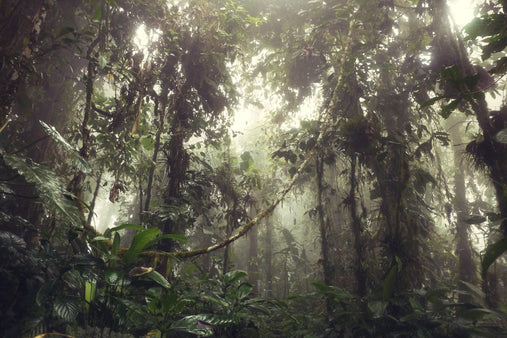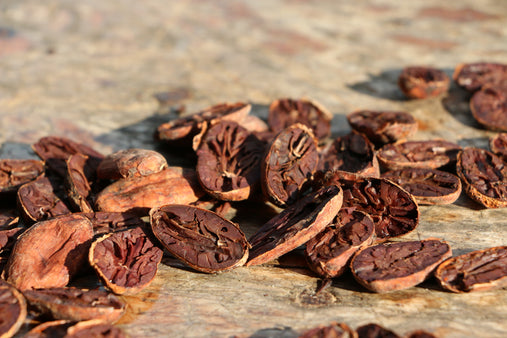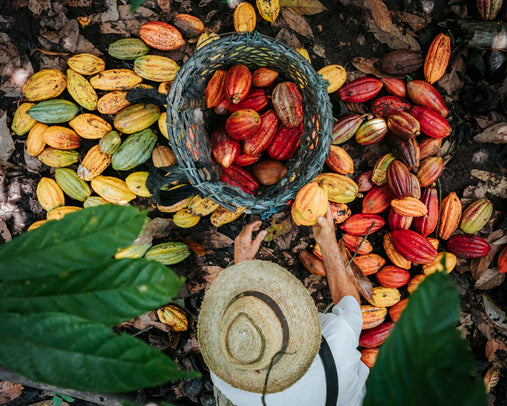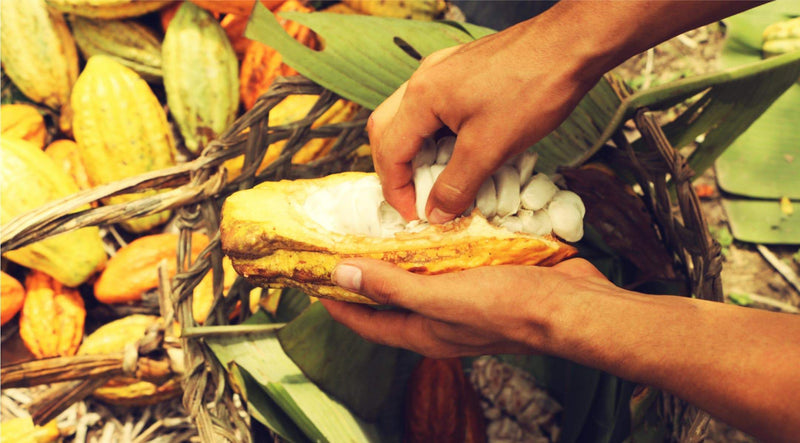
22th of January 2019
Summary: A primer to distinguish the various different grades of Ecuadorian cacao, from the best to the rest. A recommended resource for Ecuadorian cacao growers, bean-to-bar-chocolate makers, and dark chocolate consumers.

Introduction
Cacao geneticists recognize up to eleven varieties of cacao, also known as genetic clusters. One of these eleven cacao varieties is called Nacional, which is native to Ecuador and is generally regarded as the most coveted cacao variety in the world. Its fame in the global market dates back several centuries, although its ancient origins run much deeper. It was and still is cherished for its aroma and flavor profile rather than its yield, which is low.
In the present day, the term Nacional, as it refers to Ecuadorian cacao, is often misused and generally misunderstood. Any reference to Nacional cacao, without further explanation, is a gross simplification of an evolving matrix of genotypes and phenotypes.
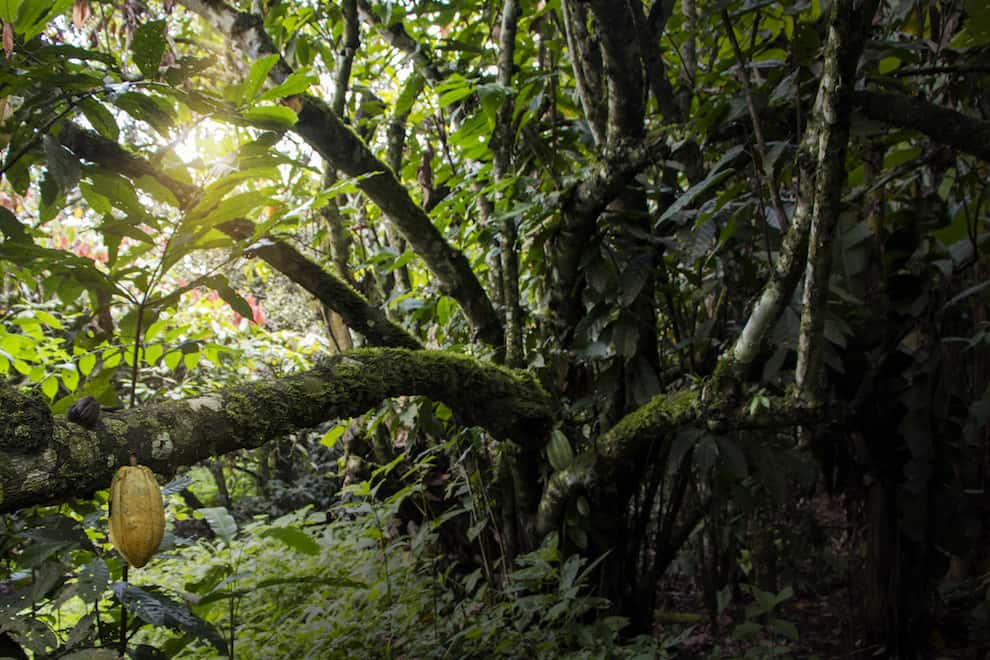
Ancient Nacional tree in Piedra de Plata, DNA-verified to be 100% pure Nacional. In the range of 100-120 years old.
The Scourge
The complications began about a hundred years ago. In the late 1800s and early 1900s, it is surmised that all cacao grown in coastal Ecuador was 100% genetically-pure Nacional[1]. Starting in 1916, there was a back-to-back outbreak of two plant diseases (Frosty Pod and Witches’ Broom), which infected cacao across the country. Production was crippled. Foreign cacao varieties, initially in the Trinitario[2] family of cultivars, were subsequently introduced to Ecuador in response to this crisis. For a deeper look into this historical and genetic process, check out "The Near Extinction of Ancient Nacional Cacao."
The genetic interaction of Nacional cacao with these foreign cacao varieties over the course of the next century is what defines the genetic landscape of Ecuadorian cacao today. During the first few decades of this process, the hybridization that occurred was natural, in the sense that different cacao varieties cross-pollinated with each other in the same plantation, producing baby cacao trees with mixed genetics and different characteristics. The flavor of these early hybrids—which is still exceptional—evolved in a fruitier direction, though still retaining much of Nacional's hallmark floral notes. Disease resistance was improved but yields remained fairly constant. The productive power of CCN-51 cacao. High yields + poor flavor characteristics = a nice solution for mass-production.
The productive power of CCN-51 cacao. High yields + poor flavor characteristics = a nice solution for mass-production.
The Plot Thickens
Then during the latter half of the twentieth century, a handful of agronomists and institutions started breeding Nacional cacao with specific cultivars from other varieties. They used hand-pollination to do this. Their primary aim was to create higher-yielding cultivars with greater resistance to diseases. Flavor and aroma characteristics became a lesser priority.
The most extreme example of this process was the creation of a cultivar known as CCN-51, which genetically and phenotypically bears almost no relation to Nacional cacao. To call this the Frankenstein of the cacao world is a tempting analogy, although not entirely fair. Its productivity is spectacular and its flavor characteristics are poor.

Classification System
The chart above lists each grade of Ecuadorian cacao, ordered according to the hierarchy of quality and rarity. The genetic and phenotypic distinctions are informed from the DNA analysis of cacao trees in Piedra de Plata that we performed in partnership with the Heirloom Cacao Preservation Fund, the USDA genetic lab, and INIAP[3]. For an in-depth analysis, please read “Genetic and Morphology Analysis of Nacional Cacao in Piedra de Plata.”
Admittedly, this classification system is also an oversimplification of an evolving matrix, but it’s an important step toward correcting certain misunderstandings. It can also be used as a primer for chocolate makers who are looking to source Ecuadorian cacao as well as farmers in Ecuador who are interested in cultivating cacao in the Heirloom Nacional spectrum.
Below is a detailed breakdown of each grade.
***
Ancient Nacional
Ancient Nacional sits at the very top of this and every other list cacao in the world, in terms of quality. This variety is older than written language in South America. It emerged sometime between 3300 B.C.E. and the arrival of the first Spanish explorers to the continent. Genetically, it is 100% pure Nacional. It was believed to be extinct as of 2009, until small pockets of relic trees were found in a couple of valleys, including Piedra de Plata. Ancient Nacional is still currently on the brink of extinction. It is limited to a very small fraction of one percent of all cacao grown in Ecuador and continues to dwindle every year. It is the rarest and most rarified cacao in the world. “Ancient Nacional” is the term used by the USDA genetic lab in partnership with the Heirloom Cacao Preservation Fund when classifying this variety.
- Designations: Heirloom & Fine Flavour
- Yield Relative to CCN-51: 6-8x less productive
- To’ak Price Premium: 8x the local farmgate price for wet cacao

DNA-verified 100% pure "Ancient Nacional" tree in Piedra de Plata, sporting one pod of production during harvest.
Heirloom Nacional
Heirloom Nacional trees are the progeny of surviving Ancient Nacional trees that naturally hybridized with the initial wave of Trinitario cacao trees introduced to Ecuador during the decades following the 1916 disease outbreak and pre-dating the earliest release of INIAP’s high-yield “Complejo Nacional” cultivars in 1978. The genetic composition is typically in the range of 70-99% Nacional crossed with the varieties that comprise Trinitario, which includes Criollo, Amelonado, and Upper Amazon Forestero[4] varieties. Based on what I’ve seen on the ground, in combination with what I’ve read in dozens of scientific and technical papers and confirmed through conversations with veteran Ecuadorian cacao specialists at institutions like INIAP and ESPAM[5], I estimate that “heirloom” Nacional cacao represents approximately 5% of Ecuador’s current cacao production. The Heirloom Cacao Preservation Fund recognizes appellations in Ecuador with unusually high concentrations of heirloom Nacional cacao. Piedra de Plata earned this designation in 2015.
- Designations: Heirloom & Fine Flavour
- Yield Relative to CCN-51: 3-4x less productive
- To’ak Price Premium: 3-4x the local farmgate price for wet cacao
In the DNA analysis we conducted in 2015, this particular tree was measured at 80% Nacional, with Criollo and Amelonado genetics representing the minority. A good example of Heirloom Nacional.
Complejo Nacional
"Complejo Nacional" cultivars are a class of relatively higher-yield clones and hybrids that INIAP created by breeding heirloom Nacional cacao trees with specific cultivars from various other varieties. The first of these cultivars were released to the public in 1978, and more continue to be developed today. Some of the more successful cultivars include EET-96, EET-103, EET-515, EET 575, EET-800, and EET-801. The genetic composition of these trees has a wide range; for the most part, the Nacional genotype is the dominant minority. The cacao produced by these trees is still rightfully classified as “fine flavour,”[6] a designation reserved for only the top 5% of global cacao production, but it falls short of “heirloom” designation. According to a study by representatives from the European Union, Complejo Nacional cultivars currently represent 25% of Ecuador’s cacao production, although they’re rapidly losing ground to CCN-51. “Complejo Nacional” is the term used within Ecuador to describe this class of cacao.
- Designations: Fine Flavour
- Yield Relative to CCN-51: About 2-3x less productive
- To’ak Price Premium: To’ak has not purchased this grade of cacao yet
This is a Complejo Nacional cultivar at a farm in Calceta. The cultivar is most likely EET 103. Quite a bit more productive than Heirloom Nacional.
CCN-51
CCN-51 was developed by an independent cacao breeder in Ecuador in 1965 and released to the public in 1984. Its genetic composition is: 1.1% Nacional, 45.4% IMC, 22.2% Criollo, 21.5% Amelonado, 3.9% Contamana, 2.5% Purús, and 2.1% Marañon[7]. It is not considered heirloom nor fine flavour. In fact, it is the poster child for what the industry refers to as “bulk cacao.” According to a study by representative from the European Union, it currently represents 70% of Ecuador’s entire cacao production. According to Ecuador’s Ministry of Agriculture, CCN-51 represents 90% of all cacao that has been planted in the country over the last twenty years[8]. It is also spreading throughout other countries in Latin America and Africa.
- Designations: Bulk cacao
- Yield Relative to CCN-51: N/A
- To’ak Price Premium: To’ak does not purchase this grade of cacao
CCN-51 tree in the province of Los Rios.
Additional Reading
- For more information about the genetic research that is behind this assessment, please refer to “Genetic & Morphology Analysis of Nacional Cacao in Piedra de Plata.”
- For a more polemical discussion of the price disparity paid to Ecuadorian farmers, you can read "What's Wrong With Cacao Farming."
- For a more detailed history of the rise and fall of Nacional cacao in Ecuador, you can find it in “The Near Extinction of Ancient Nacional Cacao.”
- To learn about our conservation project to preserve Ancient Nacional before it goes extinct, you can check out “The Genetic Bank of Ancient Nacional Cacao.”
Notes & References
1. Loor Solórzano R.G., Risterucci A.M., Courtois B., Fouet O., Jeanneau M., et al. (2009) Tracing the native ancestors of modern Theobroma cacao L. population in Ecuador. Tree genetics and genomes, 5 (3): 421–433. [20100330]. doi:10.1007/ s11295-008-0196-3.
2. Trinitario is not an official variety of cacao. Rather, it is a term used to describe a group of cacao cultivars which most likely originated in the island of Trinidad during the 1700s through early 1900s. As genetic research in the field of cacao continues to advance, Trinitario is slowly becoming somewhat of an outdated term, although it’s still useful in some contexts. Genetically, it is a hybrid of Amelonado, Criollo, and Upper Amazon Forastero (Ucayali/Scavina, Curaray, IMC, Parinari, Nanay, and Purús). Along with Nacional and Criollo cacao, Trinitario is officially designated as “Fine Flavour” cacao in the international market.
3. INIAP is the acronym for Ecuador’s Agricultural Research Institute (Instituto Nacional de Investigaciones Agropecuarias), the leading cacao research institution in Ecuador.
4. “Upper Amazon Forestero” is an umbrella term that refers to the various genetic varieties, all of which originated in the Upper Amazon region of Ecuador and Peru. These varieties include: Ucayali/Scavina, Curaray, IMC, Parinari, Nanay, and Purús.
5. ESPAM is the acronym for the province of Manabí’s polytechnic university (La Escuela Superior Politécnica Agropecuaria de Manabí), which manages an experimental cacao plantation and is arguably the second leading cacao research institution in Ecuador.
6. “Fine Flavour” is a designation of quality issued by the International Cocoa Organization (ICCO). According to the ICCO, in the beginning of the 20th century, 40-50% of the global cacao supply was considered Fine Flavour. Today, that number has dropped to about 5%. It is estimated that Ecuador accounts for 61% of the world’s Fine Flavour cacao, followed by Peru (15%) and Colombia (12%).
7. Boza E., Motomayor J.C., Amores F., Cedeño-Amador, Tondo C., et al. (2014) Genetic Characterization of the Cacao Cultivar CCN 51: Its Impact and Significance on Global Cacao Improvement and Production, JASHS 139: 2219-229.
8. Cedeño Amador, Sergio. (2011) La Revolución del Cacao CCN-51 en el Ecuador. CMAA Internacional Cocoa Conference.
Featured products
More from us
